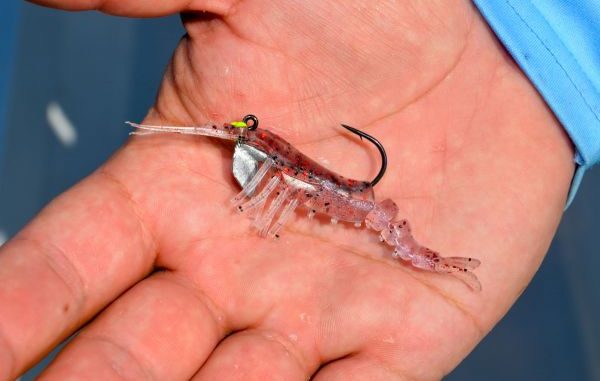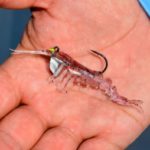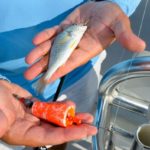
“Play the wind,” is Capt. Brandon Carter’s opening advice on how to find Venice speckled trout during high-river periods.
What Carter wants is for the wind to be blowing out — away from the bank toward open water.
In Venice, you can find that with almost any wind direction because of the way the delta protrudes into the Gulf like a thumb.
“That’s one of the advantages of Venice,” Carter explained.
The wind blowing away from the bank blows freshwater, which is lighter than saltwater and floats on its surface like a lens, away from the bank.
Heavier, saltier water comes in from offshore along the bottom to replace the surface waters that the winds have blown out, in a process scientists (and Carter) call “upwelling.”
The experienced charter captain divides the high waters of springtime into two periods: February through April and May through June.
Each demands different tactics for success:
February-April
During this period, Carter looks for calm water where fish are comfortable.
“At that time of year, they aren’t interesting in spawning,” he said. “They want slack spots with easy foods.”
Also, because of upwelling (if you are fishing on the right side of the delta wind-wise), the water is 1 or 2 degrees warmer.
“That doesn’t sound like a lot, but it makes a big difference,” Carter said.
He concentrates his effort during this time of year on what he calls “outside coves within major bays.” Major bays include Garden Island, Redfish, Blind, Customhouse, and East and West bays.
“The ones to look for,” he coached, “are open to the Gulf, 3 to 5 feet deep, and located near major passes. Ponds in the deep interior of the bays are not as open to the outside, are more influenced by river water coming through the lesser passes.”
Carter, who likes to fish during high tides, noted that a bigger tide range will bring in more salty water. The pockets of saltier water are still there, but less noticeable with smaller ranges.
Some of these coves are small enough to troll into and fan-cast in their entirety. In larger ones, he drifts across the coves with the wind, casting as he drifts.
Most of the time, he continues to drift when he catches a fish because they are usually scattered.
That’s not a carved-in-stone rule, however.
“You have to pay attention, because they can bunch up at any time,” Carter said.
During this period, Carter’s preferred live baits of croakers and shrimp are not available. Instead, he fishes 99 percent of the time with soft-plastic lures set under a cork.
His favorite corks are scoop-faced wire models with bead rattles.
“The noise of the cork gives trout something else to come to,” he said with a grin.
A favorite soft plastic is a ¼-ounce Vudu Shrimp. He frequently ends up with a pearl lure with a chartreuse tail, but quickly admitted that he uses all colors.
“I’m not a color person,” he said. “It’s very seldom I see one color out-fish another. You hear people say, ‘Fish dark baits in muddy water.’ That’s bull.
“I catch plenty fish in muddy water with light baits. Anything resembling opening night is good in any water.”
May-June
In May, speckled trout move out of coves and concentrate more to the tips of long points along major passes. There, the fish concentrate on key structure — old, submerged stubble of dead rouseau canes that used to be a pass end or an island.
Often this stubble is well away from where the living canes now occur.
May begins the transition to using live bait, although plastics will still produce fish. Carter mainly uses shrimp, but he will also turn to croakers if he can get them.
Croakers are better bait, he said, but his preference is to use them in sandy or beach areas. Over stubble, he prefers shrimp because they don’t tend to dive into the stubble crevices as much as do croakers.
Both natural baits are fished under corks using a 4x treble hook. Shrimp are hooked under the horns on tops of their heads. Croakers are hooked by pushing one hook through the upper jaws from the bottom.
Carter noted that a couple of other options exist for May-through-June fishing.
The first is fishing with live bait at oil and gas platforms, such as the Breton Sound, Sandy Point, and Main Pass rigs. These speckled trout tend to be larger than those caught over stubble, and once the fishery starts it lasts all summer.
Fishing at the rock jetties at South and Southwest passes is another important option.
“Fish in the rocks, as close as possible,” Carter advised. “The week leading to a full moon is the best. I believe big, spawning trout are at the ends of those passes then. If I am using croakers for bait, I use a sliding cork to keep them suspended right over the rocks because they want to dive into the rocks.
“Pass a Loutre doesn’t have rocks, but you can catch trout over stubble there. I use 3/8-ounce jigs fished tight-line 90 percent of the time. My favorite lure is the Deadly Dudley Strait Tail Grub, and I usually use opening night color. I fish with a lot of light-colored baits, unlike most guides down here
“The Strait Tail gives me a darting action that I like, and I can feel the bait so that I can work it. A Vudu flutters.


